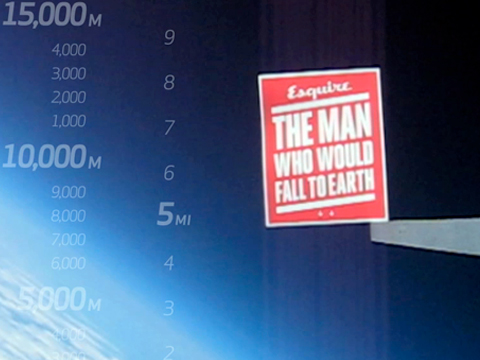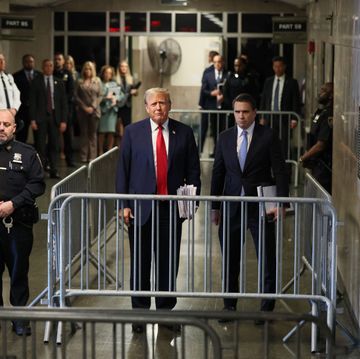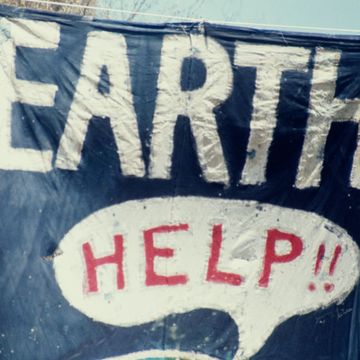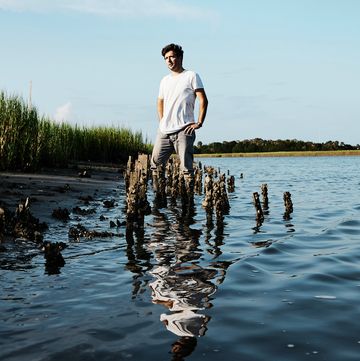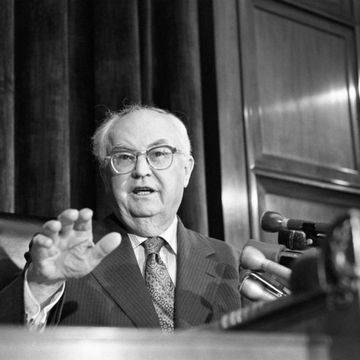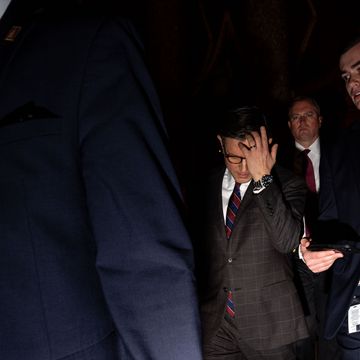To see balloonist Robert Harrison's full photos from space, read this and more stories on overcoming the impossible in Esquire's August 2010 issue
UPDATE (October 14, 2012): So, the Man Fell to Earth — Does It Matter?
--
Published in the August 2012 issue of Esquire
He was alone when he discovered she was gone.
His son and the other children, along with the other husbands and the other wives, were down the hall, in the large briefing room where their NASA escorts had told them to wait. The escorts had hustled them from the landing strip to the briefing room shortly after it became clear that the shuttle had missed its scheduled arrival time. They wouldn't answer any questions, just stood there grim and silent. And so he slipped out the first chance he got and walked down the hall and unlocked the door to the small office that typically is used by whichever ground-based flight surgeon is assigned to the current shuttle mission. The job of the flight surgeon is to monitor the health of the astronauts from afar. Dr. Jonathan Clark had the key to the flight surgeon's office because he himself was a flight surgeon, had worked six shuttle missions in the past, though for the current shuttle mission, STS-107, his only role was that of an anxious spouse waiting for his wife to return from space. He ducked into the office and closed the door. The office had a television. He turned it on.
The screen showed a bright blue sky with a single trail of plasma scratching across it, becoming then two trails, then three trails, then more. The television told him that the video came from a news crew on the ground in Dallas. He watched the trail trifurcate against the blue sky, performed some rough calculations in his head. Over Dallas, she would be about two hundred thousand feet above the surface of the earth. She was too high. She was gone.
He shut off the television and returned to the rest of the group. He sought out his eight-year-old son and went and stood by him. He said nothing to him. He didn't know what to say.
Less than fifteen minutes before, he and the others had all been sitting on bleachers on the tarmac of the three-mile-long landing strip at the Cape, watching the big media-friendly countdown clock as it ticked down the seconds to the shuttle's arrival. Speakers flanked the countdown clock, and the speakers had been broadcasting in real time the transmissions between mission control and the shuttle. Until about T minus fifteen minutes, the chatter had been the usual dry swapping of info: speeds and altitudes and so on. But then mission control began picking up readings that indicated some sort of problem with the shuttle's landing gear, with its tires.
"Columbia, Houston, we see your tire-pressure messages and we did not copy your last."
"Roger, bu — "
Those were the last words from the ship. The people in mission control continued their side of the conversation for several minutes, and the families sitting in the bleachers by the field continued to listen in. And then the speakers were cut off, and the families were left with just the big numbers on the countdown clock, which descended toward zero and then, having reached it, reversed course, began to ascend. Shortly afterward, the cell phones of the NASA escorts who had been assigned to the families all began to ring at once, like in the movies when all the cops at a bar or a wedding are suddenly called to duty. The escorts then hustled them urgently, without explanation, to the briefing room, where Dr. Jonathan Clark, husband of astronaut Laurel Clark, now stood by his son, silent, thinking about scratched blue skies over Texas.
Eventually, a friend of his, the director of flight-crew operations, Bob Cabana, entered the briefing room and faced them, the sons and daughters and wives and husbands.
"We don't have confirmation," Cabana said, "but from what we gather, the vehicle broke up at an altitude that was not survivable."
Even during these first moments, unequivocally the worst of his life, Clark didn't allow himself the comfort of denial, of hope. He knew that it was true. He knew that it was impossible, in 2003, for his wife or anyone else to survive a fall from space.
The balloon will be big, then huge, then immense. At first, it will be a flaccid and empty sack made from forty acres of .0008-inch thick polyethylene. Empty, the $250,000 balloon will weigh three thousand pounds. But it will not stay empty. The balloon handlers will pump roughly $50,000 worth of helium into it, transforming it from a big sack into what looks like a huge, fifty-six-story-tall upside-down raindrop. At that point, in accordance with the familiar, enduring magic of helium, it will weigh less than nothing at all. It will rise. It will rise with enough force to yank the twenty-five-hundred-pound custom-designed pressurized space capsule in which Felix Baumgartner will be sitting off the ground and up into the sky. For about three hours, the balloon will rise, and as it ascends through the warm, rich air of the troposphere, past the buffeting winds of the jet stream, and on into the cold, weatherless, low-pressure realm of the stratosphere, the balloon will continue to grow, to expand, its 115,000 cubic feet of helium becoming more than 30 million cubic feet of helium, until by the time it levels off at roughly 120,000 feet, it will have transformed from a huge raindrop into an immense distended sphere, it gaseous guts straining against its thin skin.
Kevin Hand
Twenty-three miles up, the sky of day is black, not blue, and one day this summer, when Felix Baumgartner opens the door to his pressurized capsule and looks out, he will see the strange vista of a black-skied summer day from a height that only one jumper has reached before. Nick Piantanida, like Felix, was handsome, charismatic, and brave. He was also, in 1966, ahead of his time — he'd contracted with a production company to document his feat and envisioned pitching various television networks a reality television series that would chronicle his attempts to break outlandish records. Felix and Nick share lots of other similarities. Even the names of their respective projects echo each other: "Red Bull Stratos" and "Project Strato Jump." But if all goes well, if the Red Bull Stratos team, a remarkable group of engineers and test pilots and physiologists and neurologists and space-suit designers, succeeds in mobilizing the necessary expertise and building the necessary equipment to keep Felix alive, there will end up being at least one salient difference between Felix and Nick.
It is very easy to die in the stratosphere.
For example, if the visor of the David Clark Company pressure suit that Felix will be wearing were to unexpectedly pop open, as did the visor of the David Clark Company pressure suit that Nick was wearing, several things would happen in quick succession.
First, the air in his lungs would instantly multiply 120 times over in volume. If Felix reacts to the shock of the explosive decompression by holding his breath, his lungs will rupture like overinflated balloons. If he does let the air escape through his mouth and nose, he will soon experience the novel sensation of the saliva on his tongue beginning to boil. He will be nearly sixty thousand feet above "Armstrong's Line," where water's boiling point drops to 98.6 degrees. Within moments, the water in his subcutaneous tissues will begin vaporizing as well. This, in combination with the expansion of any interior gases — unfarted methane in his guts, for example — will, in a process called ebullism, quickly cause Felix's own body to inflate, becoming as tumescent as a bodybuilder's. Useful consciousness, mercifully, will be gone within fifteen seconds, probably sooner, though he might remain alive, swelling, distorting, for five to eight minutes.
But let's imagine the visor stays closed. Let's imagine the suit stays intact, that its $200,000 full-body embrace succeeds in replicating the atmospheric conditions far below, protecting him from the near vacuum. Let's imagine he survives long enough to clamber out of the capsule.
This will be a critical moment. Felix's capsule, designed by some of the same people who designed the B-2 stealth bomber, takes NASA's Apollo capsule as its inspiration, though there are a few key differences. Ease of egress, for example. Another man who once tried skydiving from the stratosphere, a Soviet military officer named Pyotr Dolgov, smacked his visor on the door of his own capsule as he was climbing out, creating a small crack. The ebullizing Russian still managed to fall free, and his parachute opened automatically, lowering the dead man slowly to the ground.
But let's imagine Felix safely exits the door, that he stands on the narrow ledge just outside, that he rises to his full height and looks out at the curving horizon of the earth. Let's imagine that he jumps.
The precise manner in which he jumps will also be critical. Felix is an experienced skydiver, knows how to control himself while falling, how to perform pivots and turns and spins and flips at will. But there is no air to speak of up here, none of the warm, rich, thick atmosphere he is accustomed to swimming in. There is nothing for him to work with. Which means that for at least the first five miles of his fall, Newton, not Felix, will be in control. If when he jumps his right foot, which is his dominant foot, pushes off even slightly harder than his left, he will fall in a leftward spin, and there will be nothing he can do to stop it.
Regardless of whether or not he's spinning, gravity will likely propel Felix to approximately 690 miles per hour — the speed of sound, within the first half minute of his fall. No falling man has ever survived accelerating through the sound barrier, so nobody knows what will happen at this point. Some members of the Stratos team worry that the resulting sonic boom, and the shock waves from it, might be capable of ripping a hole in the suit. The shock waves could certainly accelerate Felix's existing spin or, if he's managed to stay stable so far, initiate a new one.
If he does spin, by about ninety thousand feet, the thickening atmosphere may enable Felix to use his skydiving skills to arrest his rotation, stabilizing himself. It is also possible that the thicker atmosphere will affect his body the way wind does a pinwheel, accelerating the spin. A sustained high-rpm spin would eventually cause him to lose consciousness. Nobody knows at precisely what number of revolutions per minute Felix would die, though tests on monkeys have demonstrated that at 145 rpm and above, the brain stem tends to separate from the spinal column.
But let's imagine none of these things happen. Let's imagine that everything goes as planned, that his suit works, that he departs the capsule safely, that he jumps with perfect form and balance, that breaking the sound barrier doesn't cause him any problems, that he falls straight and true and fast, pressurized and unebullized and neuroanatomically intact.
Then he should be fine.
Sometimes, even now, seven years after Columbia, Dr. Jonathan Clark wishes that when the ship went down, he had obeyed his instincts, had followed through on a plan that had begun to take shape during those first terrible moments in the briefing room. He wishes he had taken his son, Iain, and headed west, the two of them, to some state like Arizona or New Mexico, some place still not too heavy with roads, and simply disappeared forever. Clark is a man who feels most at home in the outdoors, who admits to liking wilderness more than he likes people, and he is also a scientist, a man who appreciates the fine edge of Occam's razor, the intrinsic beauty of the simplest solutions. This plan of his appealed to both those aspects of his nature. He would have simply started a new life in the wild. He would have simply left the wreckage of his old life behind.
But that is not what happened.
What happened is that less than five hours after Columbia disintegrated, Clark and Iain were placed on a Gulfstream II jet at the Cape Canaveral Air Force base and flown to Ellington Airport, in Houston, where their home was. NASA Casualty Assistance Calls Officers were waiting when the plane touched down. CACOs hadn't been called to duty since Challenger in 1986, but you wouldn't have known it, they were so organized. The first thing they did, right there at Ellington Airport, was separate Iain from Clark. A CACO drove away with Iain, and Clark learned later that they had gone on an outing to the Kemah Boardwalk. Another CACO took Clark home and helped guide him through the first steps of the grieving process. The CACO got him drunk. Very, very drunk. He stayed drunk for a solid day and a half.
By the time Clark began to sober up, a mass of relatives and friends and colleagues had somehow gained access to his house, congealing there. He couldn't have escaped even if he still had the will to. And he never quite did.
He never escaped the wreckage.
Even today, sitting here on the fourth floor of the Sheraton Phoenix Downtown, sliding his Dell laptop across a coffee table, spinning it so that an old friend can see the PDF on the screen, he's not far from the wreckage. He can cue it up with a few keystrokes.
Clark carries this particular laptop everywhere with him, and it is a remarkable repository. A tour of its hard drive provides a glimpse of the personal and professional odyssey he has undertaken in the seven years since Columbia went down.
The SCSIIT documents are among the oldest files, and they are the hardest to look at. SCSIIT stands for Spacecraft Crew Survival Integrated Investigation Team. NASA convened the team in 2004, a year and a half after the "mishap," as the agency termed it, and provided it a few million dollars to pursue answers to two questions. First, how, exactly, did the Columbia astronauts die? Second, what steps, precisely, might be taken to help astronauts survive similar mishaps in the future?
Clark insisted on being made a member of the SCSIIT, and though he quit NASA in 2005, leaving to become a professor of space medicine at Baylor College of Medicine, he never left the investigation. He threw himself into it. For three years, from 2004 until 2007, he immersed himself in the gigabytes of evidence that chronicled the minutiae of his wife's death.
And so, with a few keystrokes, he can launch an extremely detailed CGI simulation of Columbia's final moments, tumbling out of control in the thin outer limits of the stratosphere. Or he can cue up a PDF of his wife's autopsy report, complete with color photographs of her body, her face, the only thing recognizable a small earring that survived the fall. Or he can launch countless JPEGs of the literal wreckage itself, the shards of twisted, plasma-scarred metal that are all that is left of the crew module, the fragments he had traveled back to the Cape to see, that he and the rest of the SCSIIT had meticulously pieced back together, had scrutinized, trying to glean from its disintegrated detritus the manner in which it had broken up around the seven astronauts, depositing them into the thin blue skies over Texas.
One morning not long after the accident, Iain told his dad that when he grew up, he wanted to become a scientist, so that he could build a time machine and go back and save Mom. Clark didn't discourage him. How could he? In a sense, Clark had built his own time machine: During the years he spent on the SCSIIT, he spent most of his waking moments living and reliving the roughly fifty-minute period between the moment when the shuttle began to reenter earth's atmosphere and the moment when the remains of the astronauts hit the ground. He steeped himself in the specifics of it, the physics of it, the forensics and aerodynamics and thermodynamics of it, absorbing obscure facts about the melting temperature of nylon seat belts and the ballistics of pressure-suit helmets.
He learned exactly how she died.
But the answer to the second question — how might she have survived? — remained elusive. There were too many unknowns. The final version of the SCSIIT report, the four-hundred-page document that NASA released in 2008, is on the laptop, too, and it highlights some of those unknowns. For example, the team determined that the "total dispersal" of the shuttle, the moment when the crew members no longer had any protection from the elements, occurred at an altitude between 105,000 and 145,000 feet, at a speed of about Mach 10. The astronauts were probably already dead at that point, their suits burned and shredded, but had they still been alive, their suits intact, it is unknown whether they might have survived. As point number four in the executive summary of the report points out:
"The ascent and entry suit system is certified to a maximum altitude of 100,000 feet and velocity of 560 knots equivalent air speed. It is uncertain whether it can protect a crew member at higher altitudes and air speeds."
That certified ceiling — a hundred thousand feet and 560 knots — dates back to 1960, when a young Air Force captain named Joe Kittinger rode a balloon nineteen and a half miles into the sky, jumped out of it, and survived. Despite the continual improvements in space-suit technology during the ensuing half century, NASA had never tried to push the ceiling higher, and it certainly wasn't about to now. Although solving the problem of how to return a human safely back to earth in the event of a mishap is critically important to making human spaceflight safer, by 2008 NASA had become more risk-averse than at any time in its history and had no interest in conducting hazardous experiments that might result in the loss of life, even if conducting those sorts of experiments could prevent loss of life in the future.
Clark accepted this. He accepted that NASA was not going to ask the necessary questions, perform the necessary experiments, take the necessary risks. But he didn't abandon the problem himself. He simply looked elsewhere for solutions.
The PDF on the screen right now shows the proposed schematic for the circuit board of the biometric monitoring system Felix Baumgartner will be wearing when he attempts to leap from the stratosphere later this summer. Fifteen months ago, Clark signed on as the medical director of the Red Bull Stratos project. The biometric monitoring package is designed to let Clark and the rest of the medical team monitor Felix's vital stats in near real time. Even if the other comlinks fail, they'll know instantly if something goes wrong, and might even have an idea of what exactly went wrong, so they can be ready with an appropriate course of treatment the moment Felix touches down, if he's not already beyond treatment. But Clark is a doctor, not an engineer. Which is why, when he found out that he and this old friend of his, a former NASA colleague, would both be staying here, in the Phoenix Sheraton Downtown, attending the annual meeting of the Aerospace Medical Association, he took the opportunity to corral him, to pick his brain. His friend, who is now leaning over the laptop and studying the schematic, is an M.D. and a Ph.D., a physician and an electrical engineer, and remains one of NASA's leading experts in space-medicine hardware design, the crucial spot where flesh meets tech.
He leans over the laptop, studies the schematic.
After a minute of intense staring at the screen, he perks up.
"Ah, they're using a Motorola 68HC11 processor!"
"Okay, so what does that mean?" Clark says.
"No, that's good. I wonder if these are your isolation barriers... Oh, okay these are BurrBrown isolation barriers..."
Clark asks if he would recommend any specific material to "pot" the circuit board, meaning to sheath it in a material that would protect it from vibration, shock, moisture, and the deleterious effects of a near vacuum.
"There's a bazillion different types. They can't use electrolytics — they've gotta be careful with the tantalum capacitors..."
His friend, when he's talking about spacecraft and space-suit technology, sounds exactly like Quentin Tarantino talking about movies: the same sort of wired, hyperintelligent, and hyperenthusiastic wordstream. Clark, whose speech patterns are much more measured and laconic, interrupts. He's tall, trim, has a boyish face and a Norman Rockwell — esque haircut that wouldn't look out of place in 1953, the year he was born.
"We need something very specific," Clark says. "You know: 'This is what we pot it with...' Because otherwise it will just happen, somebody will just make a decision, and that may be because, well, this is what they have available on the floor."
His friend leans back, looks puzzled.
"Well, that gets back to your safety process," he says.
"Yeah, well, don't go there."
"I mean," he continues, "you should have a bunch of TPSs. You should be bringing this thing into a certain kind of bond. No one even touches those things without a TPS!"
"I know, but this is, you know, this is commercial space. I tell you, it's a whole different ball game."
"But Jon, you're putting a guy in a hazardous environment, and if you don't have any control and pedigree over who handles... It reminds me of a limerick I know: 'There once was a gay from Khartoum / Who took a lesbian up to the room / They argued all night / Over who had the right / To do what, and with which, and to whom.' It's the same thing! You've gotta know who's touching what, and with which, and to whom with these devices. How are you accepting product from the vendor? How do you know the pedigree? I mean, it comes in, and then from then on, anyone comes near that thing, a TPS is filled out!"
Andy Pilmanis, an aerospace physiologist who is another member of the Stratos medical team, is here as well.
"If you applied the standards you're talking about to this project," he says, "this project is dead right now."
"Oh, wow," Clark's friend says, shaking his head.
Clark knows that working on the Stratos project is very different from working for NASA. You have to lower some of your standards and accept that you don't have a gang of twenty thousand government employees looking over your shoulder, checking your work, spitting out safety protocols. But that's also precisely what makes Stratos great. It's more like Mercury than the shuttle: They're taking risks, making things up as they go along. But they're also doing important work, potentially groundbreaking work. They're doing what NASA no longer has the balls to do. Hell, he'd do it for free. He is doing it for free. Stratos only picks up his travel expenses.
Clark looks at his friend, shrugs.
"This is new space."
This is new space.
Right here, by this trailer at the Perris Valley Airport, eighty miles southeast of L. A., where the Stratos team is milling around in the dry heat, waiting for Felix to wash his hair. He had shown up looking great, as usual. He's forty-one years old and Austrian, but his style is California teen from bottom to top: fuzzy Vans, designer jeans, and a tight black T-shirt that reveals the words tattooed on his right forearm: BORN TO FLY. That same slogan is embroidered onto a predistressed baseball cap available for sale on Felix's Web site, but Felix himself is not wearing any sort of hat today. A hat might have messed up his hair, which early on this Thursday morning, in this hot drop zone, was spiked to perfection with gel.
The gel was a problem.
The gel could kill him.
In the pure-oxygen environment that exists inside a pressure suit, a petroleum-based product like hair gel becomes as volatile as napalm. Even the tiniest spark — the merest crackle of static electricity, say — could ignite it, setting his handsome head ablaze.
Luckily, somebody noticed the gel and Felix was sent off to the bathroom to rinse it out before donning the suit.
One of the doctors on the Stratos team shakes his head.
"We've already talked about this. We've talked about it several times: 100 percent oxygen environment, any type of petroleum product, any type of ignition at all... you're on fire." The doctor plans to put on a demonstration for Felix, swabbing some cotton balls with Vaseline, setting them on fire, hoping that will make the threat sink in.
Felix's confusion is understandable. Being camera-ready is an important, even essential, part of what he does. The greatest moments of his life are all on film. Take the Jesus jump a few years back, when he leapt from the outstretched hand of O Cristo Redentor, the ninety-eight-foot-tall statue that looms over Rio de Janeiro. The greatness of that moment was predicated on the fact that it had been recorded, preserved. His job wasn't just to survive the feat but to survive the feat and be recorded while doing so, and the final product was not just a world rec-ord — lowest BASE jump ever — but, more important, a visual record: The handsome man leaping toward his death from the iconic colossus, plummeting earthward for an instant, and then, the next, floating away over the favelas, buoyant and ecstatic under a rectangular chute that doubled as a mobile billboard for Red Bull, his primary sponsor, the company that pays for his globe-trotting, death-defying publicity stunts, the company that, in return, insists upon having these feats documented on film so that they can be played over and over, attracting the eyeballs of just the sort of young, adrenaline-craving men who serve as the company's customers.
This is new space.
This is Joe Kittinger, almost eighty-two years old, the retired Air Force colonel who survived that historic jump in 1960, the one who established the known limits of speed and altitude for every pressure suit since. He pulled up this morning, tires spitting gravel, in an Audi TT roadster. Kittinger holds one of the longest-standing aeronautical records of all time but has graciously, in return for a fee, agreed to help the Stratos team break it. He has sat down with Felix and patiently explained some of the things that could go wrong during this sort of jump, many of which he experienced for himself. On that day in 1960, for example, the glove of his pressure suit experienced a small leak, and although a wrist seal prevented any other part of his body from taking a hit, his hand underwent partial ebullism, swelling quickly to at least double its size, the limits of the glove the only thing that prevented his hand from ballooning even further. On an earlier, lower stratospheric jump, Kittinger's pilot chute deployed prematurely and, meeting no air resistance, floated listlessly around his neck, then pulled taut as the atmosphere thickened, initiating an uncontrolled flat spin of approximately 120 revolutions per minute and knocking him out. Kittinger, saved by his emergency chute, which automatically deployed, didn't regain consciousness until he landed fourteen miles below.
But Felix will be jumping from a significantly higher altitude than Kittinger did, and unlike Kittinger will probably be breaking the sound barrier, so there are some aspects of this endeavor that no man can really prepare him for. Although Felix respects Kittinger's accomplishments, he takes a lot of his advice with a grain of salt. "All these old-timers, they want to do what worked for them," Felix says. "When Joe came on board, the first thing he recommended was doing the whole thing with a round parachute. Everybody's sitting there like, 'Joe, it's 2008!' " Even some of the not-so-old-timers involved in Stratos, as far as Felix is concerned, are a little out of touch. For example, Jim Bagian, a former NASA astronaut who is seventeen years older than Felix and has been on two shuttle missions, suggested that the simplest solution to any urological-venting needs the jumper might encounter during the three-hour-long ride to altitude was to wear a diaper. Ridiculous, as far as Felix is concerned. He's opted instead for a condomlike slip-on system, which will allow him to wear the stylish formfitting Nomex underwear he's been eyeing. "Heroes don't wear diapers," he explains. "It's just not cool." In general, he projects an attitude that meshes nicely with the nickname he's cultivated: "The God of the Skies."
This is new space.
This is Luke Aikins, wandering around in his blue batwinged jumpsuit and fiddling with the camera assembly on his helmet. Felix and Aikins will be making a pair of test jumps today, and Aikins will be documenting them with his helmet cam, seeing if Felix can control his falling body while his space suit is almost fully pressurized. Aikins is Stratos's "aerial strategist," which means it is his job to help Felix figure out how to adapt his existing near-earth jumping skills to the near-space altitude he'll be encountering later this summer. Like a lot of people involved in Stratos, however, Aikins sometimes strays outside the role prescribed for him, taking on additional duties. He's developed a device that he believes might save Felix's life if Felix enters an uncontrolled flat spin in the stratosphere. It's an accelerometer-based piece of tech that Felix can strap to his wrist. If it determines that Felix is spinning fast enough to generate 3.5 g's for six seconds straight, the device will automatically deploy a stabilizing drogue chute. Aikins determined that 3.5 g's was the limit by lying on his belly on a rotating platform hooked up to the engine of a buddy's tractor and letting her rip. Aikins plans to patent the device.
This is new space.
This is Red Bull, or at least the two micromanaging women Red Bull has assigned to wrangle the various media in attendance today, media who are both witnesses to and essential partners in the advent of space exploration in the service of advertising. Felix's pressure suit will be exhaustively branded, as will his capsule and his parachute. There's a big cooler that looks like a giant can of Red Bull outside the main Stratos trailer here, and it is filled with cans of the ultracaffeinated stuff. Unfortunately, Red Bull is also carbonated, which means that Felix will not be able to actually drink it during his trip to the stratosphere: The bubbles might expand, hurting or even killing him.
This is new space.
This is Jonathan Clark, chatting with a young doctor he recruited to Stratos. The doctor's name can't be revealed, as he works for a government organization that does not want to acknowledge its participation. Perhaps it's enough to say that this organization, like NASA, has a vested interest in understanding what happens to people at extremely high altitudes. And this young doctor, like Clark, has discovered that these days, the best way to probe certain questions is to look beyond the overly cautious, chokingly bureaucratic thicket that old space has become. The two are talking, opaquely, about an ebullism treatment protocol they've developed in the event that Felix's suit experiences a breach above Armstrong's Line. They were surprised, when they started researching such a protocol last year, to discover that none existed.
Clark is wearing a baseball cap bearing both the Stratos slogan, MISSION TO THE EDGE OF SPACE, and the year in which the mission was originally supposed to be accomplished: 2009. The delays don't bother Clark. He'd rather be delayed than rushed. In his experience, any space project faces four basic challenges: politics, economics, technical risk, and schedule risk. Schedule risk is the risk that comes with being pressured to move too fast. It was endemic at NASA, and is, NASA itself has acknowledged, partly to blame for the demise of Columbia.
With Stratos, you've still got politics and you've still got technical risk.
But at least Red Bull is willing to allow them to take their time. They didn't fuss too much when 2009 slipped into 2010.
This is new space.
This is Felix finally washing all the gel out of his hair, finally getting pulled and zipped and strapped and snapped into his space suit, finally taking a slow, clumsy, flashbulb-punctuated walk to the back of the idling dual-turboprop Skyvan that waits on the tarmac, ready to lift him high into the sky.
The plan is for both of them to leave the plane in quick succession, first Aikins, then Felix. That way, Aikins will be able to film Felix during his entire free fall, and if at the end of the free fall Felix has any trouble pulling his rip cord — a very real possibility due to the cumbersome lack of mobility inherent in pressure suits — Aikins will be close enough to act as a "safety diver," swooping in to pull the cord for him.
Once they reach altitude, about twenty-five thousand feet, Aikins pulls off his oxygen mask and makes his way to the open doorway. The plane's propellers are pawing and struggling against the thin air, and Aikins grips the side of the door, his jumpsuit flapping in the hundred-mile-an-hour wind. He turns and waits for Felix to get ready. Felix's space suit, even in the dim light of the cabin, looks snazzily futuristic, shock white, except for the tinted sun visor and the numerous spots — helmet, both shoulders, both legs — taken up by red-and-yellow Red Bull logos. The David Clark Company based the design for Felix's suit on an existing one, though the company made it sleeker and, theoretically, more maneuverable during free fall. In the airplane, though, the suit is still a bit of a bear. Mike Todd, the suit technician, is leaning over Felix, helping detach him from the plane's onboard oxygen supply. Aikins watches and waits, patiently.
To understand what happens next, it helps to first understand that we humans, in our normal earthbound lives, live at the bottom of an extremely deep ocean of air. The air at the bottom of this ocean, at sea level, sags under the weight of the seventy-five miles of air above it, and the oxygen molecules at lower altitudes are consequently squashed together much more densely than those at higher altitudes. This is why a person accustomed to breathing the rich, thickly oxygenated soup that exists at sea level will very quickly become hypoxic, or oxygen deficient, if he tries to subsist for long on the thin gruel doled out at twenty-five thousand feet.
Aikins stands there, holding on, watching for Felix, who is now being helped to his feet and is lumbering slowly toward the doorway. But then Aikins isn't really waiting for Felix anymore. He is instead just gazing sort of blankly, serenely, at nothing much at all. And then he finds that he is no longer gazing at nothing but is instead looking up at the belly of the plane, watching it drift away without him. It isn't a bad feeling. It is a peaceful, dreamy sort of feeling, a little like being drunk, but different. He lies there on his back, watching the plane recede. Soon it is tiny. Aikins lazily turns over onto his belly, toward the ground, which he is now approaching at a high rate of speed. He doesn't give it much thought at first, just sort of blisses out while looking at all the pretty clouds below, but eventually his head starts to clear. He checks his altimeter, sees that he has fallen three miles, then pivots frantically around in the sky, spots Felix way above him, too far to reach. Aikins waits till he sees Felix's parachute unfurl — the suit turned out to be sufficiently limber to allow Felix to pull his rip cord, after all — and then deploys his own.
While some among the Stratos team will later express serious bewilderment over the fact that Aikins, the designated safety diver, just did about the unsafest thing a person can do in an airplane — he fell out! — others will shrug it off.
This is new space.
Accidents will happen.
A few days later and Clark is back home in Houston.
His house is new and beautiful and expensive. NASA eventually gave all the Columbia widowers and widows a large cash settlement. A framed portrait of Clark, his new fiancée, and his son, Iain, who's now fifteen years old and doesn't talk about building time machines anymore, hangs on a wall at one end of the living room. It's been seven years. You move on, as they say. Except you never really do, not all the way.
Clark's got his Dell with him again, as usual, sitting on a low table next to a big photographic history of the shuttle program. He's already filed away the data — the pics and flight reports — from the latest test jump. In the most important ways, at least, the jump went well. Felix proved he was able to control his position while in the pressure suit, corkscrewing and pivoting and diving at will. Of course, being in control at 25,000 feet doesn't mean he'll be in control at 120,000. But still. The test jump was part of the process, one more step toward the completion of the mission.
Actually, from Clark's perspective, Stratos itself is just a step toward a larger goal.
His Dell's hard drive also contains what must be one of the world's largest collections of documents relating to the various spacecraft-escape systems that the Russians and the Americans have dreamed up since the dawn of the era. He can show you a detailed blueprint, for example, of the Gemini capsule's escape system. And he can tell you about the time it was almost used, during an aborted launch in 1965, when the astronauts Wally Schirra and Thomas Stafford were strapped inside and one of the booster rockets malfunctioned. Launch protocol demanded the use of the ejection seats during precisely this sort of malfunction, but instead, according to the story, Schirra just turned to Stafford and said, "Remember the bears," which was enough to keep both men from pulling the ejection handles. Clark can even show you a picture of one of the bears, strapped into a prototype of the Gemini ejection seat, moments before it became one of the test system's many ursine casualties.
He can tell you that the shuttle also originally had ejection seats, during its first four test flights. And he can tell you that the seats were then removed, for reasons of cost and weight. He can show you photos and diagrams of a variety of other shuttle-escape systems that were mulled over and tested but ultimately never implemented. He can tell you that he knows for a fact that the Russian space-shuttle prototype, the Buran, had an ejection system that was once tested, with pressure-suit-wearing dummies, at an altitude of 130,000 feet and a speed of Mach 4. He's been trying to get detailed documentation of those tests from some contacts of his in the Russian space industry, but these sorts of things take time.
Many of the most speculative escape-system designs on his computer, especially the ones intended to allow individual humans to return safely to earth from all the way in orbit, look straight out of science fiction, despite bearing the imprimatur of the various corporations — General Electric, Lockheed — whose engineers originally blueprinted them for NASA. Dual-stage systems, for example, in which a suited-up astronaut straps herself onto the back of a lightweight heat shield, then rides it down through the most scorching, plasma-producing parts of the outer atmosphere before reaching an altitude — 100,000 feet? 120,000? — at which point, the theory goes, she could safely unstrap and skydive the rest of the way down.
There's still a long way to go for Stratos. The plan is to make two preliminary jumps, one at 60,000 feet and one at 90,000, before making the final one at 120,000. That jump is currently slated for August, but who knows. Delays are inevitable with these sorts of things. Regardless, Clark is already looking beyond that third jump, above 120,000 feet, faster than Mach 1. There's another company he's involved with, something called Excalibur Almaz, and in the next decade it plans to send tourists up past the stratosphere, into true space, into orbit.
Now, if you could get a guy to jump from up there...
This is new space.
This is passion and capitalism stoking the same grand ambitions that fear and nationalism once did. This is corporations picking up the reins of manned spaceflight at the moment when the government's will is at its lowest ebb. This is realizing that before spaceflight can ever become routine, before the ultimate human diaspora can truly begin, spaceflight will first have to be safer, right from the start.
This is taking a simple statement about what is possible — the vehicle broke up at an altitude that was not survivable — and working as hard as you can so that someday, next time, it won't be true.


